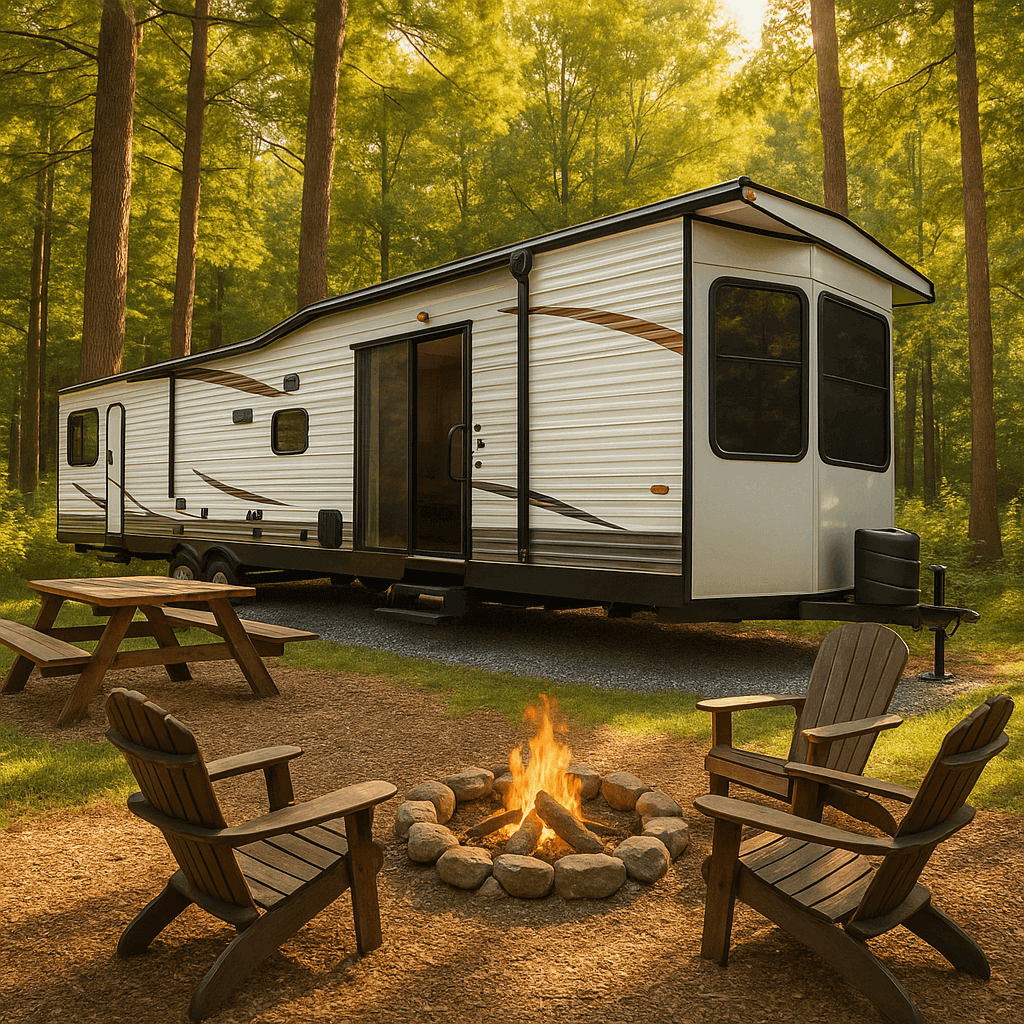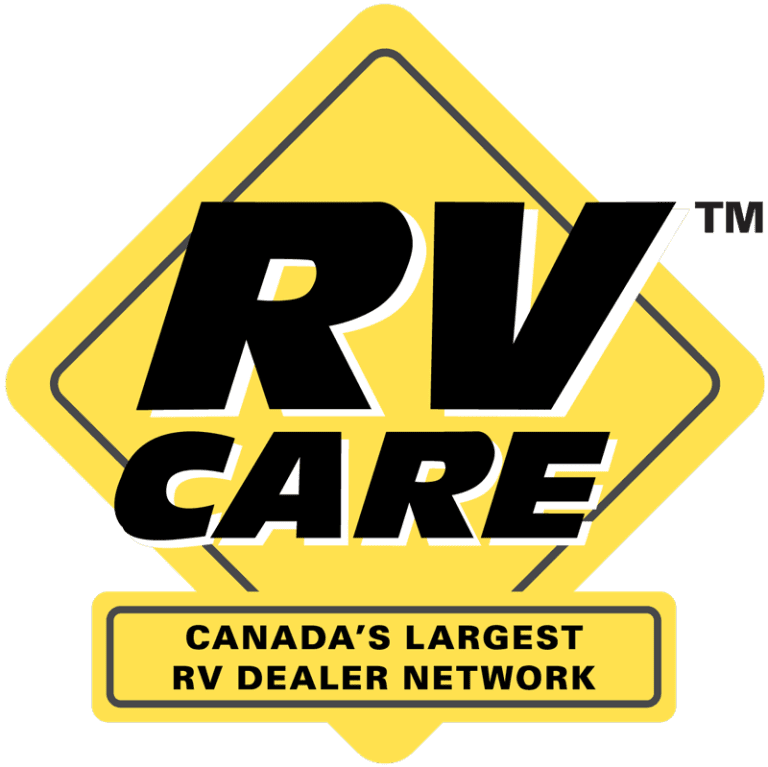More and more Canadians are finding the perfect balance between RV travel and cottage living with park models. These unique homes give you the best of both worlds – the comfort of a small house with the freedom to change locations. Let’s look at why park models have become a popular choice for outdoor lovers, weekend warriors, and snowbirds alike.

What Are Park Models? Understanding These Unique Recreational Dwellings
Park models are specialized recreational vehicles designed to look and feel like small homes. They offer more space and comfort than traditional RVs but remain transportable. In Canada, they’re typically classified as recreational vehicles, not permanent dwellings, which affects how they’re regulated and taxed.
Browse Park Model’s on RVC Navigator!
Most park models range from 300 to 500 square feet. They’re built on a single chassis and are under 12 feet wide, making them towable on highways with proper permits. Unlike travel trailers or fifth wheels, park models aren’t meant for frequent movement. They’re designed to stay in one spot for extended periods.
What sets park models apart from other RVs is their home-like features:
- Full-size appliances
- Residential-style bathrooms
- Standard-height ceilings
- Drywall interiors
- Better insulation
- Pitched roofs
While manufactured homes and tiny houses share some similarities with park models, there are key differences. Manufactured homes are built to residential building codes and aren’t meant to be moved often. Tiny houses often lack the certification and standardization that park models have within the RV industry.
The Evolution of Park Models in Canada
Park models first appeared in North America in the 1970s as a way to offer more permanent accommodations at campgrounds. In Canada, they’ve evolved to meet our unique climate needs with better insulation, stronger roofs for snow loads, and advanced heating systems.
The Canadian park model market has grown steadily over the last decade. According to the Canadian Recreational Vehicle Association, sales of park models increased by 15% between 2019 and 2023, even during the challenges of the pandemic.
Manufacturers like Forest River have adapted designs specifically for our climate and lifestyle needs. Models like the Cedar Creek Cottage and Aspen Trail by Dutchmen have become popular choices for Canadian buyers.
Benefits of Park Model Living
Home-Like Comfort in a Compact Package
Park models excel at packing home comforts into smaller spaces. Most feature:
- Full kitchens with standard-size appliances
- Spacious bathrooms with tubs or walk-in showers
- Separate bedrooms with queen or king beds
- Living rooms with full-size furniture
- Plenty of storage through clever design solutions
The interior height and design make park models feel much larger than their square footage suggests. Many use techniques like vaulted ceilings, large windows, and open floor plans to create a sense of space.
For Canadian weather, park models offer solid climate control systems. Many come with efficient forced-air furnaces, air conditioning, and even options for fireplaces or heat pumps. Four-season models include extra insulation and heated holding tanks for winter use.
Financial Advantages
A new park model typically costs between $80,000 and $150,000 – much less than a cottage or cabin in most parts of Canada. Even with land costs, the total investment is often significantly lower than buying a vacation property.
Owners also benefit from:
- Lower property taxes (often taxed as personal property rather than real estate)
- Reduced utility costs due to smaller space
- Less maintenance than a full-sized home
- Potential rental income if placed in a resort setting
Insurance costs are generally lower than for traditional homes, though you’ll need a policy that covers RVs rather than standard homeowners insurance.
Mobility and Flexibility
While park models aren’t designed for frequent travel like other RVs, they can be moved when needed. This gives owners the option to:
- Relocate seasonally between properties
- Move to different campgrounds or RV parks
- Change locations if life circumstances change
- Sell without being tied to a fixed property
Most owners set up their park models semi-permanently with steps, decks, and skirting, but maintain the ability to move if desired.
Choosing the Right Park Model for Canadian Climates
Four-Season Models for Northern Living
For year-round use in Canada’s colder regions, look for park models with:
- R-value insulation ratings of at least R-14 in walls and R-38 in roofs
- Heated and enclosed underbellies to protect plumbing
- Double-pane windows with good seals
- Properly sized heating systems for the unit’s square footage
- Thermal breaks in wall construction
Many Canadian manufacturers build to the CSA Z241 standard, which includes specific requirements for structural strength and thermal performance. This standard ensures the unit can handle snow loads and maintain comfortable temperatures in extreme weather.
Coastal and Lakefront Considerations
For park models near oceans or lakes, look for:
- Moisture-resistant materials in bathrooms and kitchens
- Proper ventilation systems to prevent mold and mildew
- Corrosion-resistant hardware for salt air exposure
- Strong tie-down systems for wind protection
Units placed in coastal areas of British Columbia or the Atlantic provinces should have upgraded features to handle higher humidity and salt exposure.
Where to Place Your Park Model
Private Land Regulations Across Provinces
Each province has different rules about placing park models on private property:
- British Columbia typically allows park models in rural areas with proper permits, but many municipalities have restrictions
- Alberta generally permits park models on properties zoned for recreational use
- Ontario rules vary widely by municipality, with many allowing park models only in designated RV parks
- Quebec has specific regulations about seasonal use and requires permits for installation
- Atlantic provinces often have more flexible rules, especially in rural areas
Before buying, check with your local municipality about:
- Zoning requirements
- Minimum lot sizes
- Setback requirements
- Time limits on occupancy
- Utility connection requirements
Top Park Model Communities in Canada
Many RV parks and resorts across Canada welcome park models, offering amenities like pools, clubhouses, and organized activities. Some top options include:
- British Columbia: Holiday Park Resort in Kelowna offers year-round park model sites with mountain views
- Ontario: Woodland Lake RV Resort near Tweed features waterfront sites and four-season access
- Quebec: Camping Choisy near Montreal has dedicated park model sections with full services
- Nova Scotia: Sunset Sands RV Park provides oceanfront sites for park models
When choosing a community, consider whether you want seasonal or year-round access. Some parks close during winter months, while others offer complete four-season facilities.
Setting Up Your Park Model
Foundation and Installation Best Practices
Proper setup is crucial for comfort and longevity. Options include:
- Concrete pad foundations for stability and levelness
- Block pier systems that allow for adjustments
- Engineered wood foundations for better insulation in cold climates
Professional installation is recommended for most park models. Companies like RV Care can connect you with qualified deralers who understand the specific needs of park models in Canadian conditions.
For DIY setup, ensure you:
- Test soil compaction before placing the unit
- Use proper leveling techniques to prevent shifting
- Follow manufacturer guidelines for weight distribution
- Install proper tie-downs for wind protection
Utility Connections and Off-Grid Options
Most park models connect to standard utilities:
- Electrical: 30 or 50 amp service
- Water: Standard residential hookups
- Sewer: Either septic systems or park connections
For remote locations, many park models can be adapted for off-grid use with:
- Solar panel systems sized for Canadian sunlight conditions
- Propane appliances for heating and cooking
- Composting toilets or holding tanks
- Water catchment systems for non-drinking water
All electrical work should be done by licensed professionals familiar with the Canadian Electrical Code.
Personalizing Your Park Model
Interior Design Tips for Maximum Comfort
Smart design choices can make your park model feel spacious and comfortable:
- Use multi-purpose furniture like storage ottomans and fold-down tables
- Choose lighter colors for walls and ceilings to create a sense of space
- Install mirrors to make rooms feel larger
- Use vertical storage solutions to maximize floor space
Canadian retailers like IKEA and Structube offer furniture sized perfectly for smaller spaces. You should also browse Shop RV Care, as they offer more than just RV parts & accessories.
Exterior Upgrades and Add-ons
Expand your living space with outdoor additions:
- Decks and porches that meet provincial building codes
- Screened rooms for bug-free outdoor living
- Awnings for shade and rain protection
- Storage sheds for seasonal items
When adding exterior features, check local regulations and ensure all work meets the National Building Code of Canada.
Financing Your Park Model Purchase
Unlike traditional homes, park models typically don’t qualify for standard mortgages. Instead, consider:
- RV loans from banks or credit unions
- Personal loans with terms from 5-15 years
- Dealer financing through manufacturers
- Home equity loans if you own a primary residence
Canadian financial institutions like TD Canada Trust offer specialized RV loan products that can be used for park models.
Most lenders require a down payment of 10-20% and offer terms up to 15 years. Interest rates are typically higher than mortgage rates but lower than personal loan rates.
Frequently Asked Questions About Park Models
What’s the difference between a park model and a tiny home? Park models are built to RV industry standards (CSA Z241 in Canada) and are legally classified as recreational vehicles. Tiny homes vary widely in construction standards and often face more legal challenges regarding where they can be placed.
Can I live in a park model year-round in Canada? This depends on local zoning laws and the park model’s construction. Many municipalities restrict full-time living in RVs, including park models. Four-season models can physically handle year-round use, but legal restrictions may apply.
Do park models qualify for mortgage financing? Not typically. Most lenders consider park models to be recreational vehicles rather than real property. RV loans or personal loans are more common financing options.
How much does it cost to transport a park model to a new location? Transport costs range from $2,000 to $5,000 depending on distance and complexity. Additional costs include setup at the new location ($1,000-$3,000) and disconnection/reconnection of utilities.
What are the tax implications of owning a park model in Canada? Park models are usually taxed as personal property rather than real estate. They may be subject to provincial sales tax at purchase and may affect income taxes differently than primary residences. Consult with a tax professional for your specific situation.
How do park models hold up in extreme Canadian weather? Four-season park models built to Canadian standards handle our climate well. Look for units with enhanced insulation, thermal windows, and proper sealing for the best performance in extreme conditions.
Are park models a good investment? Park models typically depreciate like RVs rather than appreciate like real estate. However, they offer lifestyle benefits and can be more cost-effective than other vacation property options. Well-maintained units in desirable locations tend to hold value better.
What permits do I need to place a park model on my property? Requirements vary by province and municipality. You may need development permits, building permits for foundations or additions, and permits for utility connections. Always check with local authorities before purchasing or placing a unit.
Finding Your Perfect Park Model
Park models offer a unique blend of home comfort and outdoor living. They’re perfect for weekend getaways, seasonal use, or even as a stepping stone to downsizing. With proper research and planning, a park model can provide years of enjoyment while keeping costs lower than traditional vacation properties.
Ready to explore park model options? Visit RV Care to find dealers across Canada, or check out Parks Canada for information about placing park models near national parks. You can also browse Shop RV Care for accessories and parts to customize your park model.
Whether you’re looking for a lakeside retreat, a mountain getaway, or a snowbird solution, park models offer comfort and flexibility at a price point that makes sense for many Canadians. Start your search today and find the perfect balance between home and away.





